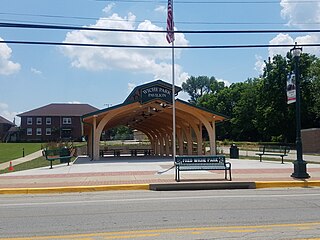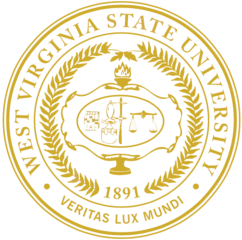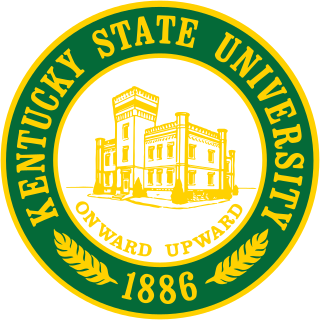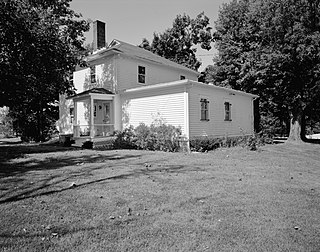
Berea College is a private liberal arts work college in Berea, Kentucky. Founded in 1855, Berea College was the first college in the Southern United States to be coeducational and racially integrated. The college provides a work-study grant that covers the remaining tuition fees after subtracting the total sum a student received from Pell Grant, other grants, and scholarships. Berea's primary service region is southern Appalachia but students come from more than 40 states in the United States and 70 other countries. Approximately one in three students identify as people of color.

Simpsonville is a home rule-class city in Shelby County, Kentucky, in the United States. It is located 8 miles west of Shelbyville, Kentucky and 23 miles east of Louisville situated along U.S. 60. The population was 2,484 during the 2010 U.S. Census.

United States Colored Troops (USCT) were Union Army regiments during the American Civil War that primarily comprised African Americans, with soldiers from other ethnic groups also serving in USCT units. Established in response to a demand for more units from Union Army commanders, by the end of the war in 1865 USCT regiments, which numbered 175 in total, constituted about one-tenth of the manpower of the army. Approximately 20% of USCT soldiers were killed in action or died of disease and other causes, a rate about 35% higher than that of white Union troops. Numerous USCT soldiers fought with distinction, with 16 receiving the Medal of Honor. The USCT regiments were precursors to the Buffalo Soldier units which fought in the American Indian Wars.
An African American is a citizen or resident of the United States who has origins in any of the black populations of Africa. African American-related topics include:

Whitney Moore Young Jr. was an American civil rights leader. Trained as a social worker, he spent most of his career working to end employment discrimination in the United States and turning the National Urban League from a relatively passive civil rights organization into one that aggressively worked for equitable access to socioeconomic opportunity for the historically disenfranchised. Young was influential in the United States federal government's War on Poverty in the 1960s.

Benjamin Lawson Hooks was an American civil rights leader and government official. A Baptist minister and practicing attorney, he served as executive director of the National Association for the Advancement of Colored People (NAACP) from 1977 to 1992.

West Virginia State University (WVSU) is a public historically black, land-grant university in Institute, West Virginia. Founded in 1891 as the West Virginia Colored Institute, it is one of the original 19 land-grant colleges and universities established by the second Morrill Act of 1890, which evolved as a diverse and inclusive campus. Following desegregation, WVSU's student population slowly became more white than black. As of 2017, WVSU's student body was 75% white and only 8% African-American.

Kentucky State University is a public historically black land-grant university in Frankfort, Kentucky. Founded in 1886 as the State Normal School for Colored Persons, and becoming a land-grant college in 1890, KSU is the second-oldest state-supported institution of higher learning in Kentucky. In fall 2019, total undergraduate enrollment was 2,029 with a total graduate enrollment of 142.

Major General Cassius Marcellus Clay was an American planter, politician, military officer and abolitionist who served as the United States ambassador to Russia from 1863 to 1869. Born in Kentucky to a wealthy planter family, Clay entered politics during the 1830s and grew to support the abolitionist cause in the U.S., drawing ire from fellow Southerners. A founding member of the Republican Party in Kentucky, he was appointed by President Abraham Lincoln as the U.S. minister to Russia, where Clay is credited with influencing Russian support for the Union during the American Civil War.

The 5th United States Colored Cavalry was a regiment of the United States Army organized as one of the units of the United States Colored Troops during the American Civil War. The 5th USCC was one of the more notable black fighting units. It was officially organized in Kentucky in October 1864, after its first two battles. It was commanded by Colonel James Brisbin until February 1865, when he took over the 6th US Colored Cavalry. His executive officer, Louis Henry Carpenter, commanded the regiment until 20 March 1866.

The Whitney Young Birthplace and Museum is a historic house museum on the campus of the former Lincoln Institute in rural Shelby County, Kentucky near Shelbyville, Kentucky. It was the birthplace and childhood home of Whitney M. Young Jr. (1921–71), an American civil rights leader. Young became prominent for his leadership of the National Urban League between 1961 and 1971. The house is now managed by the Lincoln Foundation, a successor to the Lincoln Institute, as a museum to its and Young's history. The house appears on the National Register of Historic Places and was designated as a National Historic Landmark in 1984.

Lincoln Hall is the administrative center of Berea College in Berea, Kentucky. Built in 1887 and named in honor of Abraham Lincoln, it was declared to be a U.S. National Historic Landmark in 1974 in recognition of the college's role as the first school of higher education in the nation established to provide a racially integrated educational environment.

Camp Nelson National Monument, formerly the Camp Nelson Civil War Heritage Park, is a 525-acre (2.12 km2) national monument, historical museum and park located in southern Jessamine County, Kentucky, United States, 20 miles (32 km) south of Lexington, Kentucky. The American Civil War era camp was established in 1863 as a depot for the Union Army during the Civil War. It became a recruiting ground for new soldiers from Eastern Tennessee and enslaved people, many of whom had fled their living conditions to be soldiers.

Louis Henry Carpenter was a United States Army brigadier general and a recipient of the Medal of Honor for his actions in the American Indian Wars.
Whitney M. Young Gifted & Talented Leadership Academy is a selective-enrollment public school in Cleveland, in the U.S. state of Ohio, notable as the city's first public gifted and talented school.. Named after Whitney M. Young Jr., a prominent civil rights leader, the school is located in Cleveland's Lee-Harvard neighborhood.
The Day Law mandated racial segregation in educational institutions in Kentucky. Formally designated "An Act to Prohibit White and Colored Persons from Attending the Same School," the bill was introduced in the Kentucky House of Representatives by Carl Day in January 1904, and signed into law by Governor J.C.W. Beckham in March 1904. As well as prohibiting students of color from attending the same school as white students, the law prohibited individual schools from operating separate black and white branches within 25 miles of each other.
School for the Gifted may refer to the following schools:

Eleanor Young Love (1922–2006) was an African-American librarian from Kentucky. She was the daughter of Whitney Young and the sister of Whitney Young, Jr. She worked at the Lincoln Institute., an all-black boarding high school in Lincoln Ridge, KY, formed when schools were segregated in Kentucky., where her father was president. She received her degree from Atlanta University, now Clark Atlanta University, her M.Ed. from the University of Louisville, and her D. Ed. from the University of Illinois.
Whitney M. Young Sr. was an educator from Kentucky. He was the father of civil rights leader Whitney M. Young Jr. and the first African American director of the Lincoln Institute, a school for African American students near Simpsonville, Kentucky, from 1935-1966.














